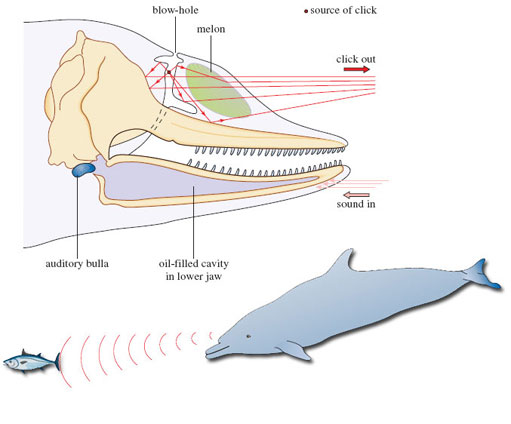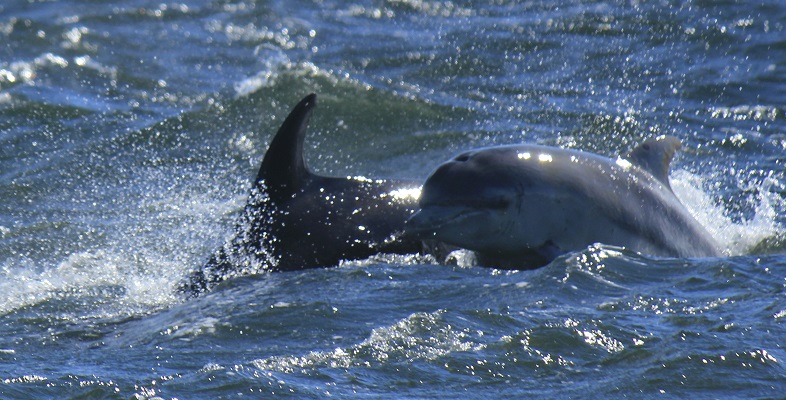2.6 Senses and communication …
Light travels only a few hundred metres through clear water, so sight is of limited use to animals hunting in deeper waters.
Seals use their eyes and sensory whiskers to search for food in relatively shallow water. Elephant seals feed at depths of 300–700 m and have eyes that adapt to poor light faster than those of any mammal tested; some six minutes compared with 20 minutes for the human eye. Despite this capacity, vision is probably of little use at the bottom of their feeding range and they must rely on sensitive whiskers and hearing. In fact, the whiskers of seals and sea lions are so important that a special blood supply at their bases keeps them warm and flexible even in the deepest, coldest waters.
Eyesight is certainly of some use in making sense of the immediate environment, and sirenians need little else to find their food in shallow, clear waters. But when hunting at depth, as many toothed whales do, communication using sound is generally a better option. Sound travels five times faster in water than it does in air, and the toothed whales use a range of high-frequency squeaks, whistles and moans to communicate with each other and coordinate social behaviour, such as the coordinated driving of fish by a pod of bottlenose dolphins, which you will find more about in Section 2.7.
You’ll also be aware that dolphins (and many other toothed whales) use a sophisticated echolocation system – ‘seeing with sound’ – to make sense of their environment and detect prey.

Dolphins produce a range of high-frequency clicks using air passages around the blow-hole (you can find many videos of dolphin clicks on youtube. This is one example of a video about how dolphin sounds work, with example audio [Tip: hold Ctrl and click a link to open it in a new tab. (Hide tip)] ). These clicks are focused by the front of the skull, which is shaped like a satellite dish, and pass out into the water through a waxy structure, the ‘melon’, which acts as an acoustic lens. In this way, the animal can focus and direct the stream of sound. The returning pulses are picked up by oil-filled cavities in the lower jaw and pass through to the inner ear, which is enclosed in a bone casing called the auditory bulla (Figure 14). This bone casing itself is surrounded by a mucus foam to isolate it from other vibrations. The whole system is sensitive enough to allow the animals to determine the size, shape and distance – even the internal structure – of objects as much as 800 m away. It is also powerful enough to allow them to stun, or even kill, their prey with a well directed burst of sound.
As well as travelling faster in water, sound also travels further and with less distortion than in air. The other suborder of cetaceans – the baleen whales – utilise this property in their use of low-frequency calls produced from the vocal cords to communicate with each other across the oceans. The song of the humpback whale is perhaps the best-known example. The song differs from population to population, and individual to individual, and it develops over time as the whales imitate each other and introduce variations. The whales also exploit a special property of the oceans to make themselves heard over great distances. At a depth of around 1000 m, there is a band of water in which temperature and pressure combine to reduce the speed of sound to a minimum. The low-frequency song of the whales can spread out through this ‘sound channel’ for distances of up to 1000 km, with little loss of energy to the water surrounding the channel.
Recent research on harbour seals and killer whales in the northeastern Pacific illustrates the sophistication of the sound world of marine mammals. The seals largely ignore a resident population of fish-eating killer whales, which use frequent echolocation clicks and communication calls. From time to time, however, the area is visited by transient pods of mammal-eating killer whales. These animals use few vocalisations, presumably to avoid alerting the seals, but the seals have learned to recognise the sounds that they do make and take evasive action.
Activity 4 Whale vocalisations
To round off this section on senses and communication, the activity introduces you to some whale vocalisations and their possible function, or functions.
Now listen to the clicks produced by sperm whales at depth. The clicks are used for echolocation but might also be loud enough to ‘stun’ squid at close range. The clicks also have a social function. In the background, you can hear the high-pitched sounds of dolphins:
Humpback whales produce a wide range of sounds that are very complex and often produced for long sessions of several hours. Listen to a short clip and marvel at the structure of the ‘song’:
Hal Whitehead from the Department of Biology at Dalhousie University in Nova Scotia has a special interest in the social structure and cultural life of sperm whales, as he told the BBC’s Julian Hector:
Transcript: Audio 3 Hal Whitehead interview
You can listen to recordings of lots of other whale species online (on Wikipedia for example).
